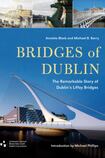
The introduction summarises bridge building from ancient times. Vikings built the first simple timber structure and Normans the first Liffey stone bridge, but by 1610, there was only one spanning the river. The 17th century saw a great period of expansion, when four bridges were added. Many more followed over the centuries to give a current total of 24. Rather than chronological, the book’s tripartite approach looks at the western bridges from Lucan to the Liffey Railway, the central bridges from the Seán Heuston to the Ha’penny, and the eastern bridges from O’Connell to the East Link.
The Liffey bridges show much variety: from the single-arched elegance of Lucan Bridge (1813) with its dark, locally quarried limestone, to the mass concrete, workaday West-Link Bridge (1990); from the “discreet yet fascinating gem” of Island Bridge (1792) to the “modern, utilitarian” Frank Sherwin Bridge (1982); and from the classic, harmonious three-arched Mellows, originally Queen’s, Bridge (1763 and Dublin’s oldest existing) to the “elegant, iconic” Samuel Beckett Bridge (2009 and Dublin’s newest), the second Calatrava-designed structure (the other being the James Joyce). Excellent illustrations accompany the fascinatingly informative text.










